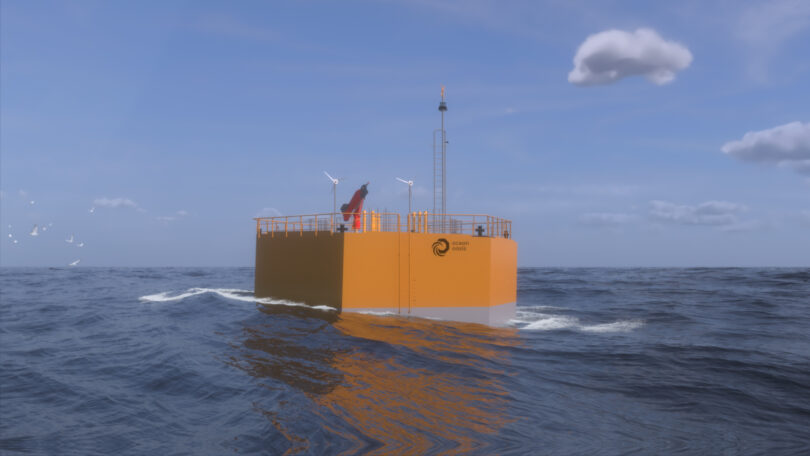Norwegian clean-tech group Ocean Oasis will turn seawater into freshwater (offshore desalination technology) using renewable wave power to address water scarcity issues on the Canary Islands.
Situated off the west coast of Africa, the islands in the archipelago face serious water shortage problems, putting pressure on already depleted water resources. As such, business and communities on the island have become much more dependent on sea water desalination for freshwater.
The consortium’s DESALIFE (Desalination for Environmental Sustainability And LIFE) project will test and validate Ocean Oasis’ wave-powered solution providing desalinated water from floating buoys in deep water off the coast of Gran Canaria.
Floating desalination buoys will increase the volume of affordable and sustainable freshwater available to the local population and farmers in the north region of the island. A pilot buoy, Gaia, has been employed already to validate the technology at a site offshore the Port of Las Palmas, made possible by co-funding from the European Innovation Council Accelerator, Innovation Norway and other funders.
Creating accessible and abundant water
DESALIFE’s consortium aims to have the first pre-commercial buoys producing fresh water by mid-2026.
Kristine Bangstad Fredriksen, CEO and Co-Founder of Ocean Oasis, said: “At Ocean Oasis we believe that by harnessing the power of renewable energy, such as wave power, we have the potential to create a future where clean water is accessible and abundant, not scarce. We are honoured to lead the DESALIFE project consortium to deliver renewable powered desalinated water, with zero emissions, to Gran Canaria. This first-of a-kind project will demonstrate our solution for the Canary Islands, and the potential to deliver fresh water to other coastal areas and island nations facing water scarcity.”
Ocean Oasis’ technology addresses the challenges associated with access to affordable and clean freshwater. More than 300 million people rely on desalination of seawater for their water supply, a number that is expected to double by 2030 due to climate change, droughts, increasing populations and urbanization.
Incorporating innovative systems
The north coast of Gran Canaria was chosen for its wave potential, operating conditions and proximity to existing onshore desalination facilities. The local population currently relies on three desalination plants for drinking water. One of those, the Arucas-Moya seawater desalination plant will contribute to the implementation and operation phases of the DESALIFE project by integrating the offshore freshwater produced by the desalination buoys with its own production.
As a result, the facility will increase production by 2,000 m3/day on average, the equivalent of the daily consumption of 15,000 people. This will be achieved without the need to expand the existing on shore plant, or increase its energy consumption, CO2 emissions or its brine discharge from shore.
The Councilor of Territorial Policy, Territorial Cohesion and Water of the Government of the Canary Islands, Manuel Miranda, highlighted the values of the project, which he said, “combines solutions to address the increasing water production demand in the Islands with an environmentally friendly alternative”.
Miranda added that the proposal is “aligned with the collaboration between diverse institutions to incorporate innovative systems to the water cycle in the Archipelago, already a pioneer when searching for formulas for obtaining fresh water”.
“The Government of the Canary Islands will continue to focus on evaluating how systems can be incorporated to not only provide greater production efficiency but also allow further deepening on measures contributing to mitigate climate change,” said Councilor Miranda.
Norwegian offshore industry experience
Ocean Oasis’ buoys produce freshwater using membrane-based desalination technology powered directly by wave induced motion, with no need for grid power, any emissions to the atmosphere and without chemicals on board. The technology has been developed for sustainable use of the oceans drawing on 50 years of experience and knowledge development in the Norwegian offshore industry.
Dr. Thomas B. Johannessen, CTO, co-founder and inventor of the offshore desalination technology commented: “We are grateful and feel privileged to be given this opportunity to take the Ocean Oasis technology to the next commercial level. Wave power is abundant, and a concentrated energy form compared with solar and wind power. Whereas the power of the waves must be treated with respect in engineering and design of offshore structures, the pilot testing carried out to date suggests that direct desalination is a very good way to utilise wave energy bypassing many of the challenges associated with electricity production by wave power.”
The DESALIFE consortium received nearly €6 million in funding from the European Executive Agency on Climate, Infrastructure and Environment (CINEA) under its framework of Circular Economy and Quality of Life Programme. The project will be led by Ocean Oasis Canarias, a subsidiary of Ocean Oasis, which is based in Gran Canaria.
The Consortium include key institutional and private partners: The Canary Islands Institute of Technology (ITC), The Oceanic Platform of the Canary Islands (Plataforma Oceánica de Canarias, PLOCAN), The Group for the Research on Renewable Energy Systems (GRRES) of the Universidad of Las Palmas de Gran Canaria (ULPGC) and elittoral, an environmental consultancy specialized in coastal and oceanographic engineering.
A commitment to renewable energy and offshore desalination technology
Miguel Hidalgo, vice president of the Gran Canaria Island Water Council, stated: “The participation of the Gran Canaria Island Water Council in the DESALIFE project, within the scope of insular hydrological planning, represents a strong commitment to promoting and developing reference projects aimed at harnessing renewable energy resources, such as wave energy.”
It is also a central objective in the project to investigate the scalability of the technology to provide fresh water to other islands in the archipelago, which are also experiencing water scarcity issues.
Once operational, the buoys will facilitate the transition toward a sustainable, energy-efficient and climate-resilient economy in the archipelago. They will also demonstrate that the solution has potential for use in other coastal communities, to provide emission-free, cost-effective sources of fresh water.
Related offshore desalination technology press releases:
Harnessing natural wave power for desalination
Oneka’s Floating Desalination Buoys Set to Revolutionise Water Access






